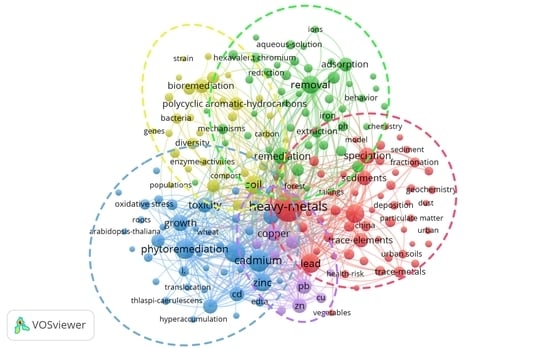Changes in the Structures and Directions of Heavy Metal-Contaminated Soil Remediation Research from 1999 to 2020: A Bibliometric & Scientometric Study
Abstract
:1. Introduction
2. Materials and Methods
2.1. Data Sources
2.2. Research Methods
3. Results and Discussion
3.1. Chronological Distribution
- (1)
- Exploratory stage (1999–2012)
- (2)
- Rapid development stage (2013-present)
3.2. Country and Institution Distribution
3.3. Source Journal Analysis
3.4. Keywords Co-Occurrence Analysis
3.5. Reference Co-Citation Analysis
4. Conclusions
Author Contributions
Funding
Institutional Review Board Statement
Informed Consent Statement
Data Availability Statement
Acknowledgments
Conflicts of Interest
References
- Armah, F.A.; Obiri, S.; Yawson, D.O.; Onumah, E.E.; Yengoh, G.T.; Afrifa, E.K.A.; Odoi, J.O. Anthropogenic Sources and Environmentally Relevant Concentrations of Heavy Metals in Surface Water of a Mining District in Ghana: A Multivariate Statistical Approach. J. Environ. Sci. Health Part A 2010, 45, 1804–1813. [Google Scholar] [CrossRef]
- Han, R.; Zhou, B.; Huang, Y.; Lu, X.; Li, S.; Li, N. Bibliometric Overview of Research Trends on Heavy Metal Health Risks and Impacts in 1989–2018. J. Clean. Prod. 2020, 276, 123249. [Google Scholar] [CrossRef]
- Li, N.; Han, R.; Lu, X. Bibliometric Analysis of Research Trends on Solid Waste Reuse and Recycling during 1992–2016. Resour. Conserv. Recycl. 2018, 130, 109–117. [Google Scholar] [CrossRef]
- Bori, J.; Vallès, B.; Navarro, A.; Riva, M.C. Ecotoxicological Risks of the Abandoned F–Ba–Pb–Zn Mining Area of Osor (Spain). Environ. Geochem. Health 2017, 39, 665–679. [Google Scholar] [CrossRef]
- Liu, S.; Wang, X.; Guo, G.; Yan, Z. Status and Environmental Management of Soil Mercury Pollution in China: A Review. J. Environ. Manag. 2021, 277, 111442. [Google Scholar] [CrossRef] [PubMed]
- Tóth, G.; Hermann, T.; Szatmári, G.; Pásztor, L. Maps of Heavy Metals in the Soils of the European Union and Proposed Priority Areas for Detailed Assessment. Sci. Total Environ. 2016, 565, 1054–1062. [Google Scholar] [CrossRef] [PubMed]
- Obrist, D.; Kirk, J.; Zhang, L.; Sunderland, E.; Jiskra, M.; Selin, N. A Review of Global Environmental Mercury Processes in Response to Human and Natural Perturbations: Changes of Emissions, Climate, and Land Use. Ambio 2018, 47, 116–140. [Google Scholar] [CrossRef] [PubMed] [Green Version]
- Brunetti, G.; Farrag, K.; Soler-Rovira, P.; Ferrara, M.; Nigro, F.; Senesi, N. The Effect of Compost and Bacillus Licheniformis on the Phytoextraction of Cr, Cu, Pb and Zn by Three Brassicaceae Species from Contaminated Soils in the Apulia Region, Southern Italy. Geoderma 2012, 170, 322–330. [Google Scholar] [CrossRef]
- Hema, T.G.; Getha, K.; Tan, G.Y.A.; Sahira, H.L.; Syamil, A.M.; Fairuz, M.Y.N. Actionbacteria isolates from tin tailings and forest soil for bioremediation of heavy metals. J. Trop. For. Sci. 2014, 26, 53–162. [Google Scholar]
- Ubando, A.T.; Africa, A.D.M.; Maniquiz-Redillas, M.C.; Culaba, A.B.; Chen, W.-H.; Chang, J.-S. Microalgal Biosorption of Heavy Metals: A Comprehensive Bibliometric Review. J. Hazard. Mater. 2021, 402, 123431. [Google Scholar] [CrossRef]
- van Nunen, K.; Li, J.; Reniers, G.; Ponnet, K. Bibliometric Analysis of Safety Culture Research. Saf. Sci. 2018, 108, 248–258. [Google Scholar] [CrossRef]
- Zhang, W.; Zhang, Q.; Yu, B.; Zhao, L. Knowledge Map of Creativity Research Based on Keywords Network and Co-Word Analysis, 1992–2011. Qual. Quant. 2015, 49, 1023–1038. [Google Scholar] [CrossRef]
- Luo, R.; Li, J.; Zhao, Y.; Fan, X.; Zhao, P.; Chai, L. A Critical Review on the Research Topic System of Soil Heavy Metal Pollution Bioremediation Based on Dynamic Co-Words Network Measures. Geoderma 2017, 305, 281–292. [Google Scholar] [CrossRef]
- Zhou, W.; Kou, A.; Chen, J.; Ding, B. A Retrospective Analysis with Bibliometric of Energy Security in 2000–2017. Energy Rep. 2018, 4, 724–732. [Google Scholar] [CrossRef]
- Cui, T.; Zhang, J. Bibliometric and Review of the Research on Circular Economy through the Evolution of Chinese Public Policy. Scientometrics 2018, 116, 1013–1037. [Google Scholar] [CrossRef]
- Bartol, T.; Mackiewicz-Talarczyk, M. Bibliometric Analysis of Publishing Trends in Fiber Crops in Google Scholar, Scopus, and Web of Science. J. Nat. Fibers 2015, 12, 531–541. [Google Scholar] [CrossRef]
- Chiu, W.-T.; Ho, Y.-S. Bibliometric Analysis of Tsunami Research. Scientometrics 2007, 73, 3–17. [Google Scholar] [CrossRef]
- Zhang, Y.; Huang, K.; Yu, Y.; Yang, B. Mapping of Water Footprint Research: A Bibliometric Analysis during 2006–2015. J. Clean. Prod. 2017, 149, 70–79. [Google Scholar] [CrossRef]
- Hood, W.W.; Wilson, C.S. The Literature of Bibliometrics, Scientometrics, and Informetrics. Scientometrics 2001, 52, 291. [Google Scholar] [CrossRef]
- Chen, C. CiteSpace II: Detecting and Visualizing Emerging Trends and Transient Patterns in Scientific Literature. J. Am. Soc. Inf. Sci. Technol. 2006, 57, 359–377. [Google Scholar] [CrossRef] [Green Version]
- Chen, C.; Ibekwe-Sanjuan, F.; Hou, J. The Structure and Dynamics of Co-Citation Clusters: A Multiple-Perspective Co-Citation Analysis. J. Am. Soc. Inf. Technol. 2014, 61, 1386–1409. [Google Scholar] [CrossRef] [Green Version]
- Chen, C.C.; Wu, C.F.; Yu, H.L.; Chan, C.C.; Cheng, T.J. Spatiotemporal Modeling with Temporal-Invariant Variogram Subgroups to Estimate Fine Particulate Matter PM2.5 Concentrations. Atmos. Environ. 2012, 54, 1–8. [Google Scholar] [CrossRef]
- Pan, X.; Yan, E.; Cui, M.; Hua, W. Examining the Usage, Citation, and Diffusion Patterns of Bibliometric Mapping Software: A Comparative Study of Three Tools. J. Informetr. 2018, 12, 481–493. [Google Scholar] [CrossRef]
- van Eck, N.J.; Waltman, L. Software Survey: VOSviewer, a Computer Program for Bibliometric Mapping. Scientometrics 2010, 84, 523–538. [Google Scholar] [CrossRef] [PubMed] [Green Version]
- Yang, F.; Qiu, D. Exploring coal spontaneous combustion by bibliometric analysis. Process. Saf. Environ. Prot. 2019, 132, 1–10. [Google Scholar] [CrossRef]
- Yang, R.; Wong, C.; Miao, M. Analysis of the trend in the knowledge of environmental responsibility research. J. Clean. Prod. 2021, 278, 123402. [Google Scholar] [CrossRef]
- Xie, L.; Chen, Z.; Wang, H. Bibliometric and Visualized Analysis of Scientific Publications on Atlantoaxial Spine Surgery Based on Web of Science and VOSviewer. World Neurosurg. 2020, 137, 435–442. [Google Scholar] [CrossRef]
- Wang, J.; Chen, C. Biosorption of Heavy Metals by Saccharomyces Cerevisiae: A Review. Biotechnol. Adv. 2006, 24, 427–451. [Google Scholar] [CrossRef]
- Liu, X.; Gao, Y.; Khan, S.; Duan, G.; Chen, A.; Ling, L.; Zhao, L.; Liu, Z.; Wu, X. Accumulation of Pb, Cu, and Zn in Native Plants Growing on Contaminated Sites and Their Potential Accumulation Capacity in Heqing, Yunnan. J. Environ. Sci. 2008, 20, 1469–1474. [Google Scholar] [CrossRef]
- Gadd, G.M. Biosorption: Critical Review of Scientific Rationale, Environmental Importance and Significance for Pollution Treatment. J. Chem. Technol. Biotechnol. 2010, 84, 13–28. [Google Scholar] [CrossRef]
- Beesley, L.; Moreno-Jimenez, E.; Gomez-Eyles, J.L.; Harris, E.; Robinson, B.; Sizmur, T. A Review of Biochars’ Potential Role in the Remediation, Revegetation and Restoration of Contaminated Soils. Environ. Pollut. 2011, 159, 3269–3282. [Google Scholar] [CrossRef]
- Ali, H.; Khan, E.; Sajad, M.A. Phytoremediation of Heavy Metals—Concepts and Applications. Chemosphere 2013, 91, 869–881. [Google Scholar] [CrossRef] [PubMed]
- Ahmad, M.; Rajapaksha, A.U.; Lim, J.E.; Zhang, M.; Bolan, N.; Mohan, D.; Vithanage, M.; Lee, S.S.; Ok, Y.S. Biochar as a Sorbent for Contaminant Management in Soil and Water: A Review. Chemosphere 2014, 99, 19–33. [Google Scholar] [CrossRef]
- Li, J.; Wang, X.; Zhao, G.; Chen, C.; Chai, Z.; Alsaedi, A.; Hayat, T.; Wang, X. Metal–Organic Framework-Based Materials: Superior Adsorbents for the Capture of Toxic and Radioactive Metal Ions. Chem. Soc. Rev. 2018, 47, 2322–2356. [Google Scholar] [CrossRef]
- Hosseini, M.R.; Martek, I.; Zavadskas, E.K.; Aibinu, A.A.; Arashpour, M.; Chileshe, N. Critical Evaluation of Off-Site Construction Research: A Scientometric Analysis. Autom. Constr. 2018, 87, 235–247. [Google Scholar] [CrossRef]
- Su, H.N.; Lee, P.C. Mapping Knowledge Structure by Keyword Co-Occurrence: A First Look at Journal Papers in Technology Foresight. Entometrics 2010, 85, 65–79. [Google Scholar] [CrossRef]
- Hu, L.; Zhang, L.; Wu, H. Experimental study of the effects of soil pH and ionic species on the electro-osmotic consolidation of kaolin. J. Hazard. Mater. 2018, 368, 885–893. [Google Scholar] [CrossRef] [PubMed]
- Oraee, M.; Hosseini, M.R.; Papadonikolaki, E.; Palliyaguru, R.; Arashpour, M. Collaboration in BIM-Based Construction Networks: A Bibliometric-Qualitative Literature Review. Int. J. Proj. Manag. 2017, 35, 1288–1301. [Google Scholar] [CrossRef]
- Zhang, Q.; Feng, Q.; Zhu, X.; Zhang, M.; Wang, Y.; Yang, L. Box Experiment Study of Thermally Enhanced SVE for Benzene. Int. J. Environ. Res. Public Health 2021, 18, 4062. [Google Scholar] [CrossRef]
- Xia, W.; Du, Y.; Li, F.; Li, C.; Yan, X.; Arul, A.; Wang, F.; Song, D. In-situ solidification/stabilization of heavy metals contaminated site soil using a dry jet mixing method and new hydroxyapatite based binder. J. Hazard. Mater. 2019, 369, 353–361. [Google Scholar] [CrossRef]
- Li, C.; Ji, X.; Luo, X. Phytoremediation of Heavy Metal Pollution: A Bibliometric and Scientometric Analysis from 1989 to 2018. Int. J. Environ. Res. Public Health 2019, 16, 4755. [Google Scholar] [CrossRef] [Green Version]
- Giller, K.E.; Witter, E.; Mcgrath, S.P. Toxicity of Heavy Metals to Microorganisms and Microbial Processes in Agricultural Soils: A Review. Soil Biol. Biochem. 1998, 30, 1389–1414. [Google Scholar] [CrossRef]
- Salt, D.E.; Smith, R.D.; Raskin, I. Phytoremediation. Annu. Rev. Plant Physiol. Plant Mol. Biol. 1998, 49, 643–668. [Google Scholar] [CrossRef] [PubMed]
- Adriano, D.C. Arsenic. In Trace Elements in Terrestrial Environments: Biogeochemistry, Bioavailability, and Risks of Metals; Adriano, D.C., Ed.; Springer: New York, NY, USA, 2001. [Google Scholar]
- Kabata-Pendias, A. Soil–Plant Transfer of Trace Elements—An Environmental Issue. Geoderma 2004, 122, 143–149. [Google Scholar] [CrossRef]
- Pulford, I.D.; Watson, C. Phytoremediation of Heavy Metal-Contaminated Land by Trees—A Review. Environ. Int. 2003, 29, 529–540. [Google Scholar] [CrossRef]
- Ma, L.Q.; Komar, K.M.; Tu, C.; Zhang, W.; Cai, Y.; Kennelley, E.D. A Fern That Hyperaccumulates Arsenic. Nature 2001, 409, 579. [Google Scholar] [CrossRef] [PubMed]
- Adriano, D.C.; Wenzel, W.W.; Vangronsveld, J.; Bolan, N.S. Role of Assisted Natural Remediation in Environmental Cleanup. Geoderma 2004, 122, 121–142. [Google Scholar] [CrossRef]
- Yoon, J.; Cao, X.; Zhou, Q.; Ma, L.Q. Accumulation of Pb, Cu, and Zn in Native Plants Growing on a Contaminated Florida Site. Sci. Total Environ. 2006, 368, 456–464. [Google Scholar] [CrossRef]
- Vangronsveld, J.; Herzig, R.; Weyens, N.; Boulet, J.; Adriaensen, K.; Ruttens, A.; Thewys, T.; Vassilev, A.; Meers, E.; Nehnevajova, E.; et al. Phytoremediation of Contaminated Soils and Groundwater: Lessons from the Field. Environ. Sci. Pollut. Res. 2009, 16, 765–794. [Google Scholar] [CrossRef] [PubMed]
- Kumpiene, J.; Lagerkvist, A.; Maurice, C. Stabilization of As, Cr, Cu, Pb and Zn in Soil Using Amendments—A Review. Waste Manag. 2008, 28, 215–225. [Google Scholar] [CrossRef]
- Glick, B.R. Using Soil Bacteria to Facilitate Phytoremediation. Biotechnol. Adv. 2010, 28, 367–374. [Google Scholar] [CrossRef]
- Wei, B.; Yang, L. A Review of Heavy Metal Contaminations in Urban Soils, Urban Road Dusts and Agricultural Soils from China. Microchem. J. 2010, 94, 99–107. [Google Scholar] [CrossRef]
- Nagajyoti, P.C.; Lee, K.D.; Sreekanth, T.V.M. Heavy Metals, Occurrence and Toxicity for Plants: A Review. Environ. Chem. Lett. 2010, 8, 199–216. [Google Scholar] [CrossRef]
- Wuana, R.A.; Okieimen, F.E. Heavy Metals in Contaminated Soils: A Review of Sources, Chemistry, Risks and Best Available Strategies for Remediation. ISRN Ecol. 2011, 2011, 402647. [Google Scholar] [CrossRef] [Green Version]
- Ali, H.; Khan, E. Bioaccumulation of selected toxic heavy metals in mastacembelus armatus from three rivers of Malakand division, Pakistan. Pak. J. Zool. 2021, 53, 1–9. [Google Scholar] [CrossRef]
- Bolan, N.; Kunhikrishnan, A.; Thangarajan, R.; Kumpiene, J.; Park, J.; Makino, T.; Kirkham, M.B.; Scheckel, K. Remediation of Heavy Metal(Loid)s Contaminated Soils—To Mobilize or to Immobilize? J. Hazard. Mater. 2014, 266, 141–166. [Google Scholar] [CrossRef] [PubMed]
- Li, Z.; Ma, Z.; van der Kuijp, T.J.; Yuan, Z.; Huang, L. A Review of Soil Heavy Metal Pollution from Mines in China: Pollution and Health Risk Assessment. Sci. Total Environ. 2014, 468–469, 843–853. [Google Scholar] [CrossRef]
- Mahar, A.; Wang, P.; Ali, A.; Awasthi, M.K.; Lahori, A.H.; Wang, Q.; Li, R.; Zhang, Z. Challenges and Opportunities in the Phytoremediation of Heavy Metals Contaminated Soils: A Review. Ecotoxicol. Environ. Saf. 2016, 126, 111–121. [Google Scholar] [CrossRef] [PubMed]
- Khalid, S.; Shahid, M.; Niazi, N.K.; Murtaza, B.; Bibi, I.; Dumat, C. A Comparison of Technologies for Remediation of Heavy Metal Contaminated Soils. J. Geochem. Explor. 2017, 182, 247–268. [Google Scholar] [CrossRef] [Green Version]
- Sarwar, N.; Imran, M.; Shaheen, M.R.; Ishaque, W.; Kamran, M.A.; Matloob, A.; Rehim, A.; Hussain, S. Phytoremediation Strategies for Soils Contaminated with Heavy Metals: Modifications and Future Perspectives. Chemosphere 2017, 171, 710–721. [Google Scholar] [CrossRef]
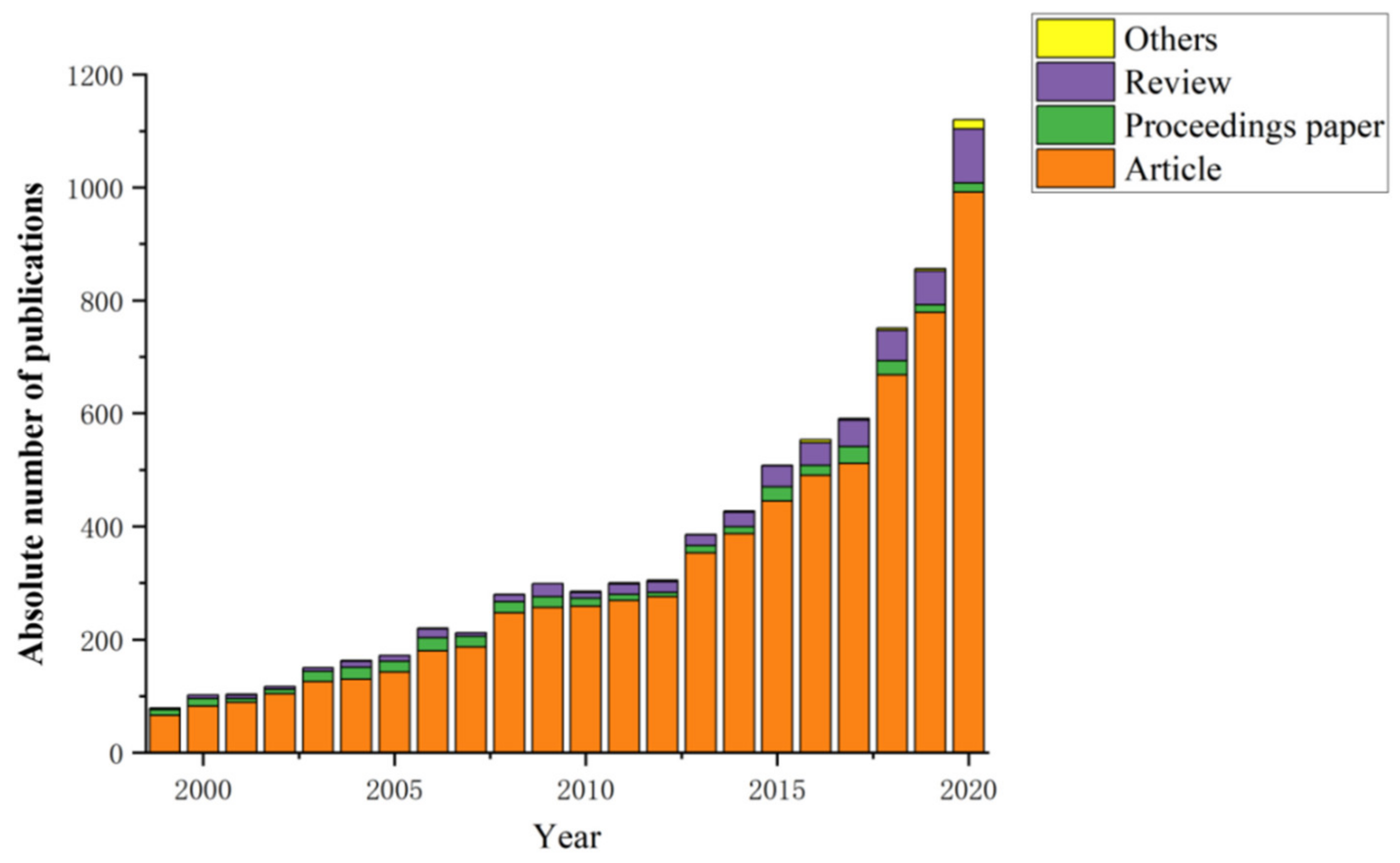
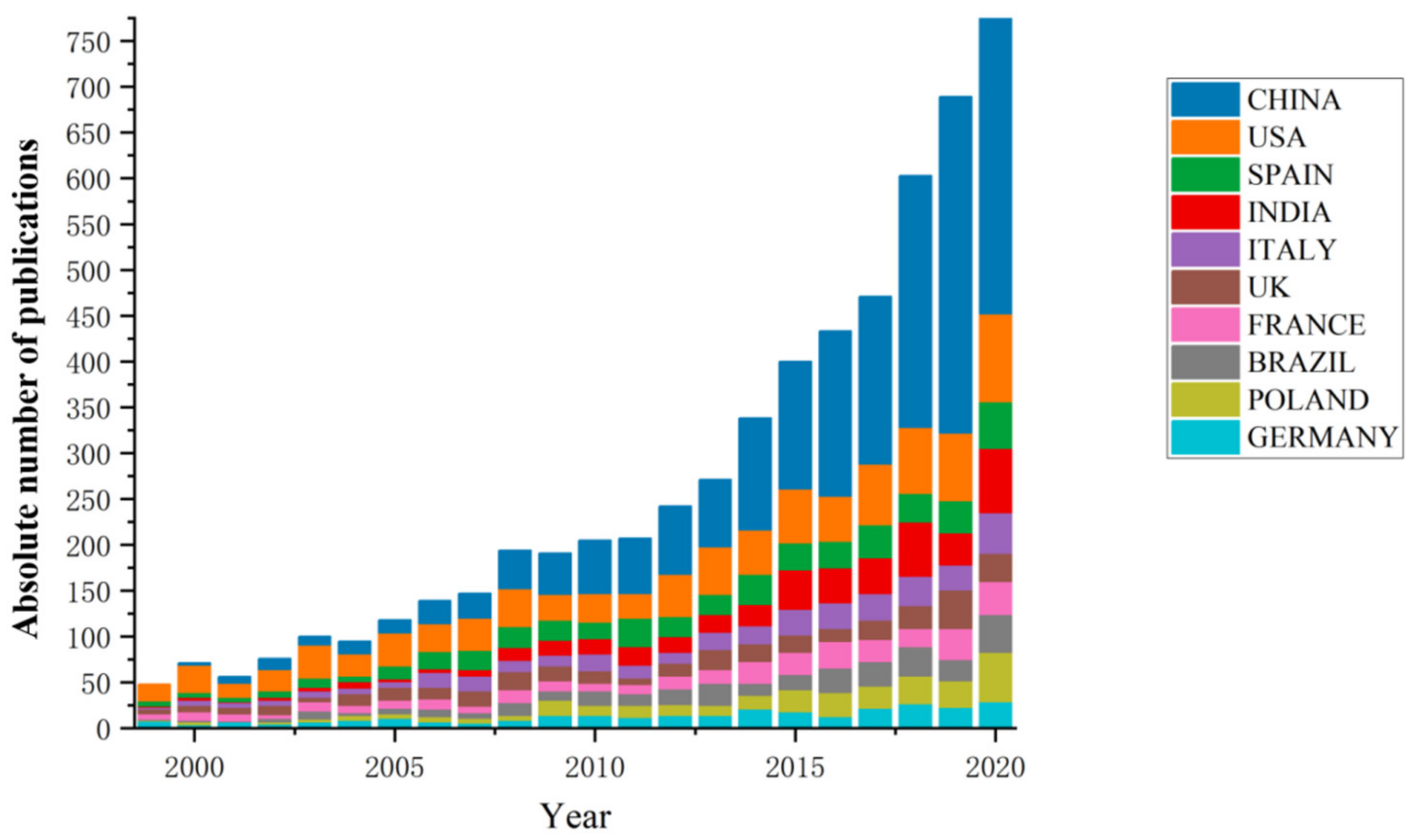

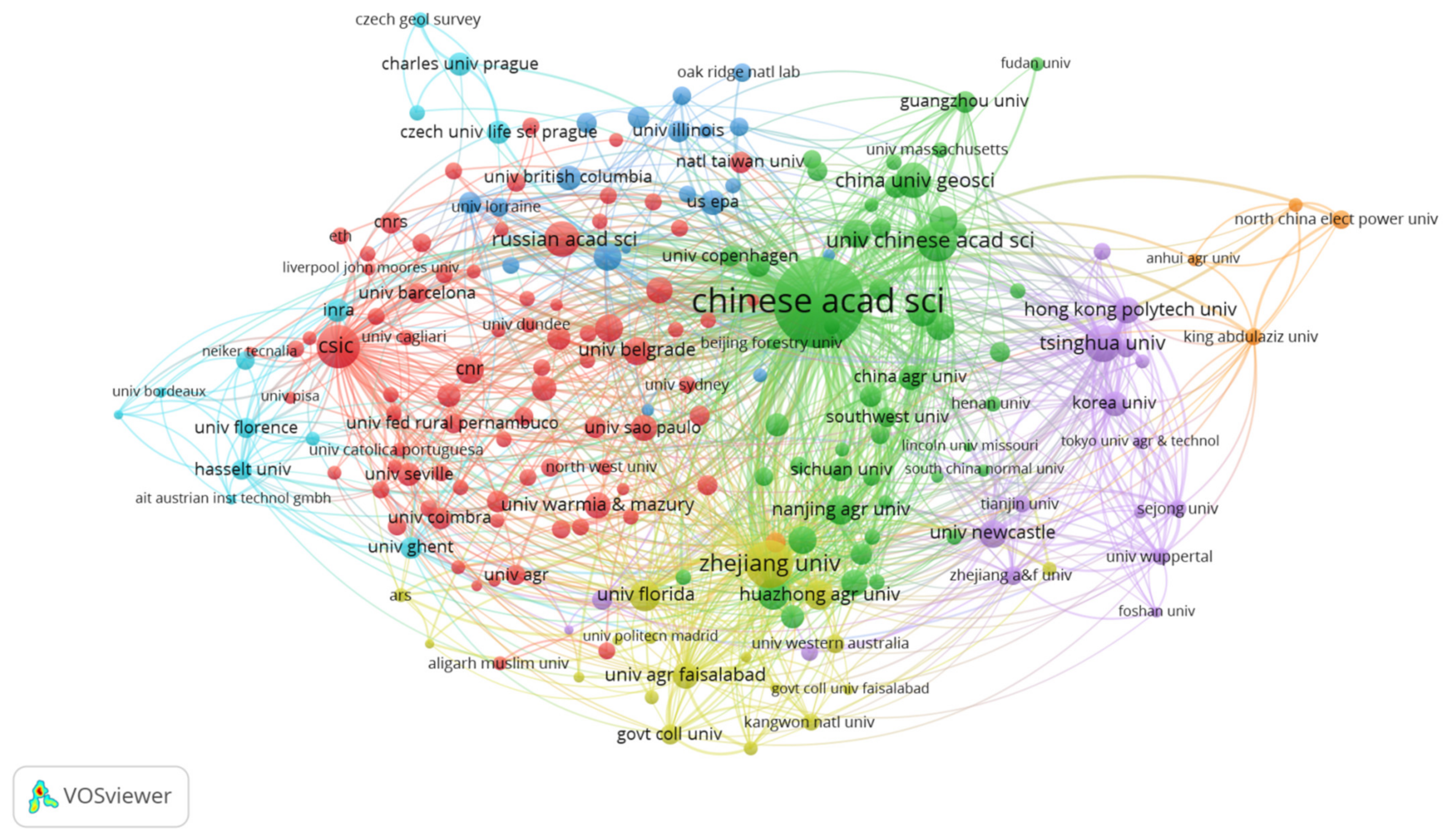
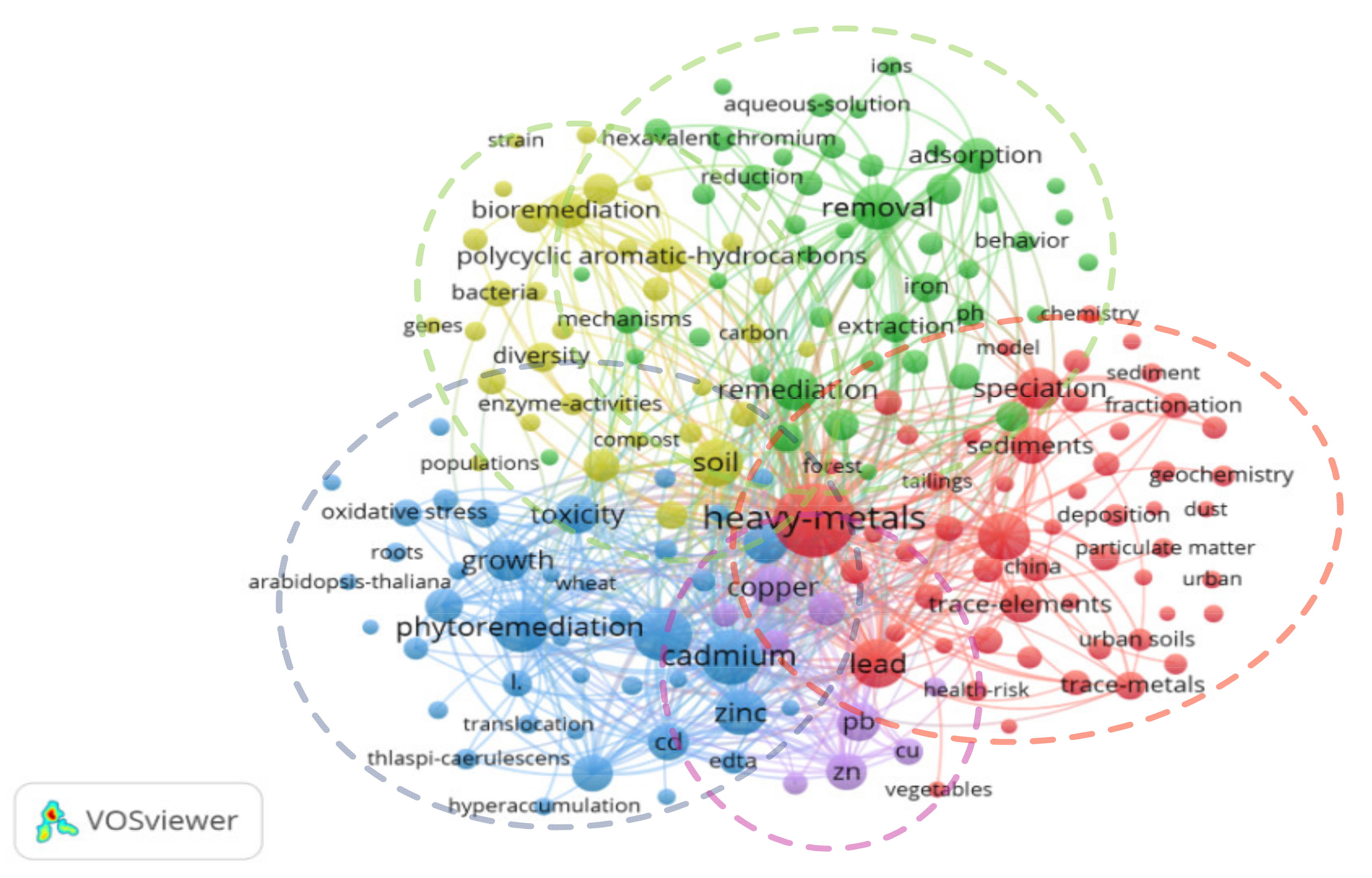
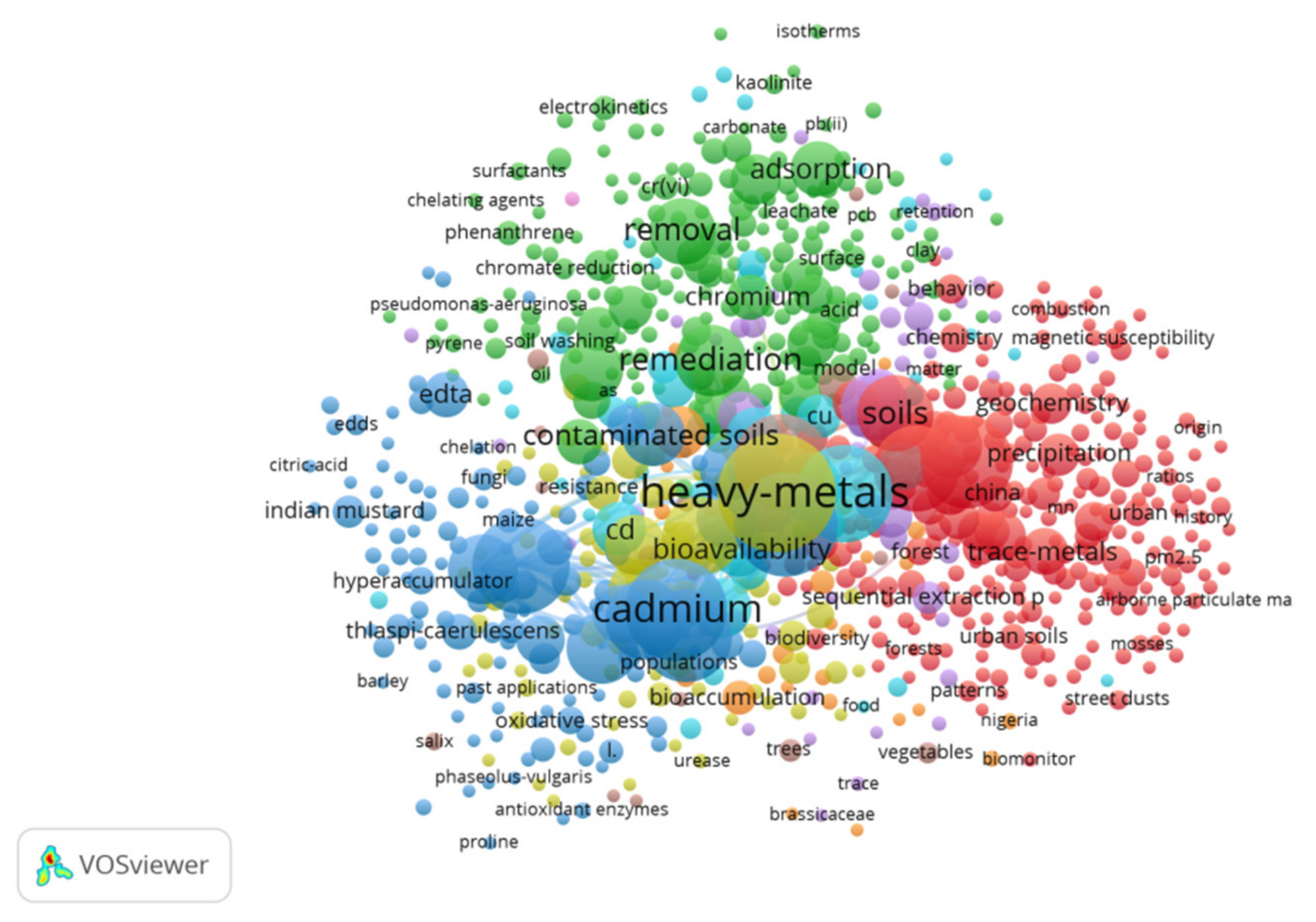
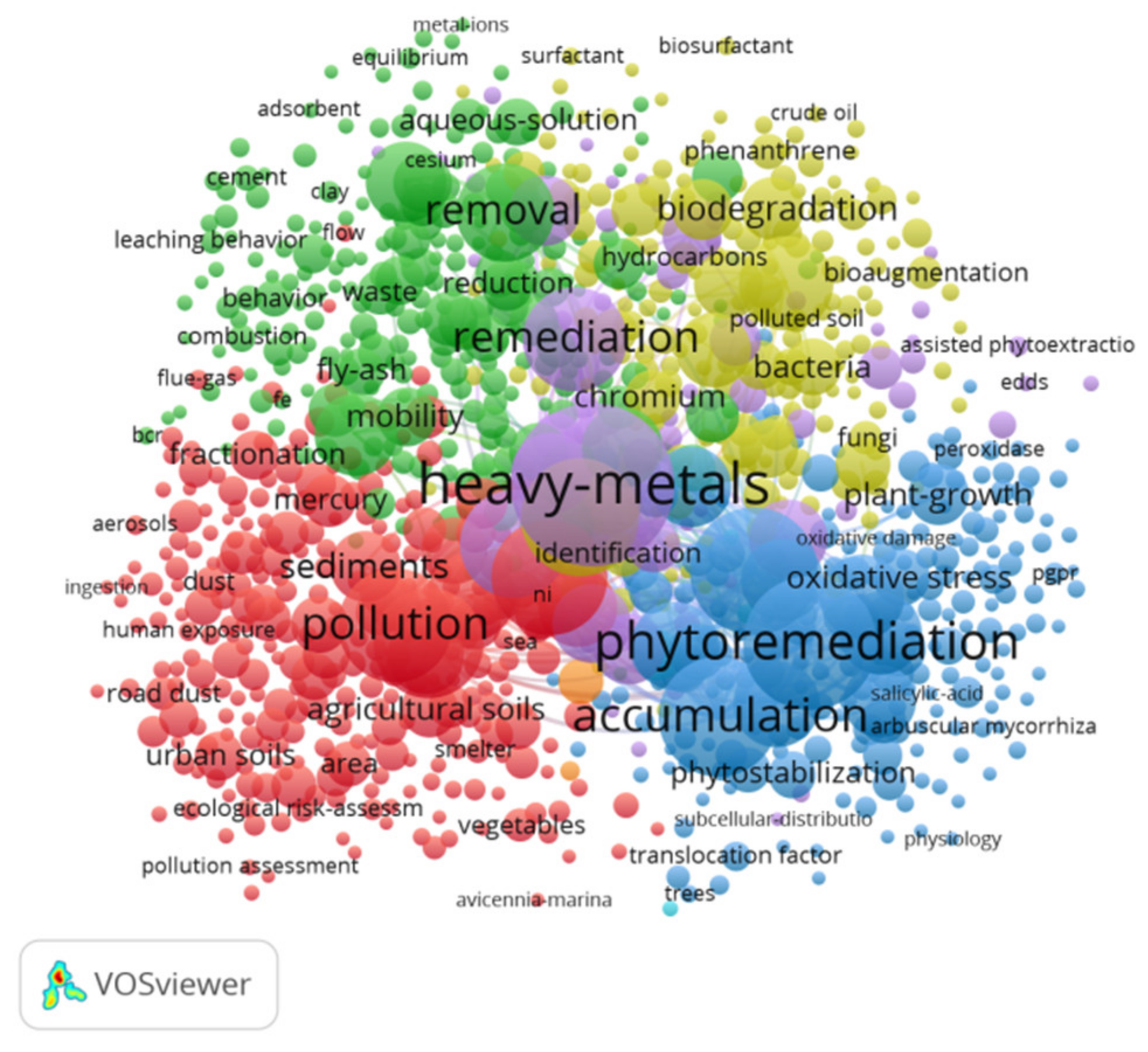
| No. | Major Terms | PMIDs of Source Article | ||
|---|---|---|---|---|
| 1 | 2 | 3 | ||
| 1 | soil | 0 | 0 | 0 |
| 2 | pollution | 0 | 0 | 0 |
| 3 | heavy metal | 1 | 0 | 0 |
| ... | ... | ... | ... | ... |
| Rank | Institution | Country/Region | Amount of Papers/Article | Citations |
|---|---|---|---|---|
| 1 | Chinese Acad Sci | CHINA | 485 | 309,762 |
| 2 | Zhejiang Univ | CHINA | 135 | 101,537 |
| 3 | CSIC | SPAIN | 111 | 86,641 |
| 4 | Univ Chinese Acad Sci | CHINA | 98 | 69,877 |
| 5 | Tsinghua Univ | CHINA | 78 | 63,363 |
| 6 | China Univ Geosci | CHINA | 77 | 43,091 |
| 7 | Russian Acad Science | RUSSIA | 74 | 19,270 |
| 8 | Univ Florida | USA | 57 | 53,040 |
| 9 | Nothwest A&F Univ | CHINA | 57 | 48,035 |
| 10 | Huazhong Agr Univ | CHINA | 53 | 42,452 |
| 11 | Nanjing Univ | CHINA | 52 | 39,840 |
| 12 | Nanjing Agr Univ | CHINA | 50 | 34,287 |
| 13 | Beijing Normal univ | CHINA | 48 | 25,135 |
| 14 | CNR | / | 46 | 19,469 |
| 15 | Univ nacl autonoma mexico | MEXICO | 45 | 46,465 |
| Journal Name | Total Publication | Percentage/% | Impact Factor (2019) | h-Index(R) |
|---|---|---|---|---|
| Environmental Science and pollution research | 384 | 5.06 | 3.056 | 98 |
| Science of the Total Environment | 345 | 4.55 | 6.551 | 224 |
| Chemosphere | 296 | 3.90 | 5.778 | 228 |
| Environmental Pollution | 226 | 2.98 | 6.792 | 211 |
| Journal of Hazardous Materials | 216 | 2.85 | 9.038 | 260 |
| Water Air and Soil Pollution | 178 | 2.35 | 1.9 | 105 |
| Ecotoxicology and Environmental Safety | 168 | 2.21 | 4.872 | 121 |
| Environmental Monitoring and Assessment | 149 | 1.96 | 1.903 | 102 |
| International Journal of Phytoremediation | 148 | 1.95 | 2.528 | 78 |
| Journal of Soils and Sediments | 129 | 1.70 | 2.763 | 65 |
| Environmental Earth Sciences | 108 | 1.42 | 2.18 | 107 |
| Environmental Science Technology | 101 | 1.33 | 7.864 | 373 |
| Journal of Environmental management | 100 | 1.32 | 5.647 | 161 |
| Environmental geochemistry and health | 90 | 1.19 | 3.472 | 68 |
| Soil sediment contamination | 84 | 1.11 | 1.25 | 45 |
| No. | Keyword | Absolute Frequency | No. | Keyword | Absolute Frequency |
|---|---|---|---|---|---|
| 1 | heavy-metals | 1925 | 21 | bioavailability | 417 |
| 2 | phytoremediation | 1253 | 22 | adsorption | 416 |
| 3 | cadmium | 1195 | 23 | cd | 390 |
| 4 | soil | 1031 | 24 | sediments | 382 |
| 5 | pollution | 952 | 25 | zn | 364 |
| 6 | accumulation | 939 | 26 | trace-elements | 360 |
| 7 | lead | 932 | 27 | immobilization | 287 |
| 8 | contamination | 875 | 28 | Polycyclic aromatic-hydrocarbons | 284 |
| 9 | remediation | 718 | 29 | biodegradation | 253 |
| 10 | zinc | 693 | 30 | sorption | 252 |
| 11 | removal | 633 | 31 | arsenic | 238 |
| 12 | bioremediation | 562 | 32 | degradation | 237 |
| 13 | plants | 548 | 33 | mobility | 228 |
| 14 | copper | 543 | 34 | extraction | 227 |
| 15 | phytoextraction | 499 | 35 | organic-matter | 225 |
| 16 | speciation | 499 | 36 | iron | 224 |
| 17 | contaminated soils | 464 | 37 | diversity | 208 |
| 18 | growth | 460 | 38 | chromium | 206 |
| 19 | toxicity | 451 | 39 | bacteria | 203 |
| 20 | pb | 438 | 40 | mercury | 201 |
| Cluster ID | Size | Silhouette | Label | Mean (Cite Year) |
|---|---|---|---|---|
| 0 | 183 | 0.711 | Plant growth | 2011 |
| 1 | 163 | 0.866 | Biochar application | 2013 |
| 2 | 155 | 0.833 | Zinc accumulation | 2004 |
| 3 | 145 | 0.815 | Sw spain | 2003 |
| 4 | 118 | 0.858 | Health risk | 2013 |
| 5 | 107 | 0.944 | Zea may | 1999 |
| 6 | 90 | 0.869 | Helianthus annuus | 2007 |
| 7 | 76 | 0.964 | Feasible soil | 1996 |
| 8 | 63 | 0.887 | Rape cultivar | 2016 |
| 9 | 62 | 0.964 | Magnetic susceptibility measure | 2005 |
| 10 | 43 | 0.946 | Bacterial community | 2014 |
| 11 | 35 | 0.997 | Situ soil remediation | 1996 |
| 13 | 21 | 0.974 | Metal ion release | 2001 |
| 14 | 20 | 0.983 | Interactive effect | 2008 |
| 15 | 18 | 0.998 | Non-urban area | 1998 |
| 17 | 14 | 0.989 | Geochemical fractionation | 2017 |
| 21 | 8 | 0.999 | Cleveland area commom | 2000 |
| 24 | 5 | 0.999 | Pollution source | 2006 |
| 28 | 3 | 1 | Waste incineration residue | 2010 |
| References | Strength | Begin | End | 1999–2020 |
|---|---|---|---|---|
| Giller K.E. [42] | 15.98 | 1999 | 2020 | ▃▃▃▃▃▃▃▃▃▃▃▃▃▃▃▃▃▃▃▃▃▃ |
| Salt D.E. [43] | 15.68 | 2000 | 2020 | ▂▃▃▃▃▃▃▃▃▃▃▃▃▃▃▃▃▃▃▃▃▃ |
| Adriano D.C. [44] | 20.96 | 2004 | 2020 | ▂▂▂▂▂▃▃▃▃▃▃▃▃▃▃▃▃▃▃▃▃▃ |
| Kabata P.A. [45] | 20.29 | 2005 | 2020 | ▂▂▂▂▂▂▃▃▃▃▃▃▃▃▃▃▃▃▃▃▃▃ |
| Pulford I.D. [46] | 18.73 | 2005 | 2020 | ▂▂▂▂▂▂▃▃▃▃▃▃▃▃▃▃▃▃▃▃▃▃ |
| Ma L.Q. [47] | 17.72 | 2005 | 2020 | ▂▂▂▂▂▂▃▃▃▃▃▃▃▃▃▃▃▃▃▃▃▃ |
| Adriano D.C. [48] | 15.79 | 2006 | 2020 | ▂▂▂▂▂▂▂▃▃▃▃▃▃▃▃▃▃▃▃▃▃▃ |
| Yoon J. [49] | 22.73 | 2010 | 2020 | ▂▂▂▂▂▂▂▂▂▂▂▃▃▃▃▃▃▃▃▃▃▃ |
| Vangronsveld J. [50] | 20.58 | 2011 | 2020 | ▂▂▂▂▂▂▂▂▂▂▂▂▃▃▃▃▃▃▃▃▃▃ |
| Kumpiene J. [51] | 19.26 | 2011 | 2020 | ▂▂▂▂▂▂▂▂▂▂▂▂▃▃▃▃▃▃▃▃▃▃ |
| Glick B.R. [52] | 16.22 | 2012 | 2020 | ▂▂▂▂▂▂▂▂▂▂▂▂▂▃▃▃▃▃▃▃▃▃ |
| Wei B.G. [53] | 17.01 | 2013 | 2020 | ▂▂▂▂▂▂▂▂▂▂▂▂▂▂▃▃▃▃▃▃▃▃ |
| Nagajyoti P.C. [54] | 21.37 | 2015 | 2020 | ▂▂▂▂▂▂▂▂▂▂▂▂▂▂▂▂▃▃▃▃▃▃ |
| Wuana R.A. [55] | 14.57 | 2015 | 2020 | ▂▂▂▂▂▂▂▂▂▂▂▂▂▂▂▂▃▃▃▃▃▃ |
| Ali H. [56] | 17.66 | 2016 | 2020 | ▂▂▂▂▂▂▂▂▂▂▂▂▂▂▂▂▂▃▃▃▃▃ |
| Bolan N. [57] | 14.26 | 2017 | 2020 | ▂▂▂▂▂▂▂▂▂▂▂▂▂▂▂▂▂▂▃▃▃▃ |
| Li Z.Y. [58] | 21.47 | 2018 | 2020 | ▂▂▂▂▂▂▂▂▂▂▂▂▂▂▂▂▂▂▂▃▃▃ |
| Mahar A. [59] | 21.11 | 2018 | 2020 | ▂▂▂▂▂▂▂▂▂▂▂▂▂▂▂▂▂▂▂▃▃▃ |
| Khalid S. [60] | 17.91 | 2018 | 2020 | ▂▂▂▂▂▂▂▂▂▂▂▂▂▂▂▂▂▂▂▃▃▃ |
| Sarwar N. [61] | 16.16 | 2018 | 2020 | ▂▂▂▂▂▂▂▂▂▂▂▂▂▂▂▂▂▂▂▃▃▃ |
Publisher’s Note: MDPI stays neutral with regard to jurisdictional claims in published maps and institutional affiliations. |
© 2021 by the authors. Licensee MDPI, Basel, Switzerland. This article is an open access article distributed under the terms and conditions of the Creative Commons Attribution (CC BY) license (https://creativecommons.org/licenses/by/4.0/).
Share and Cite
Shi, D.; Xie, C.; Wang, J.; Xiong, L. Changes in the Structures and Directions of Heavy Metal-Contaminated Soil Remediation Research from 1999 to 2020: A Bibliometric & Scientometric Study. Int. J. Environ. Res. Public Health 2021, 18, 7358. https://doi.org/10.3390/ijerph18147358
Shi D, Xie C, Wang J, Xiong L. Changes in the Structures and Directions of Heavy Metal-Contaminated Soil Remediation Research from 1999 to 2020: A Bibliometric & Scientometric Study. International Journal of Environmental Research and Public Health. 2021; 18(14):7358. https://doi.org/10.3390/ijerph18147358
Chicago/Turabian StyleShi, Dongping, Chengyu Xie, Jinmiao Wang, and Lichun Xiong. 2021. "Changes in the Structures and Directions of Heavy Metal-Contaminated Soil Remediation Research from 1999 to 2020: A Bibliometric & Scientometric Study" International Journal of Environmental Research and Public Health 18, no. 14: 7358. https://doi.org/10.3390/ijerph18147358
APA StyleShi, D., Xie, C., Wang, J., & Xiong, L. (2021). Changes in the Structures and Directions of Heavy Metal-Contaminated Soil Remediation Research from 1999 to 2020: A Bibliometric & Scientometric Study. International Journal of Environmental Research and Public Health, 18(14), 7358. https://doi.org/10.3390/ijerph18147358






